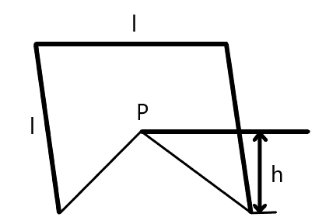
An isosceles triangle is to be cut from one edge of a square lamina (as shown in the figure) such that the remaining position when suspended from the apex

A.
B.
C.
D.

Answer
452.7k+ views
Hint: Here, a square is given from which an isosceles triangle is to be cut. Therefore, we have an isosceles triangle and square. Therefore, we will use the formula for the area of the triangle for the isosceles triangle and the area of the lamina for the square.
Formula used:
The formula of the area of triangle is given by
Here,
The formula of the area of lamina is given below
Here,
Complete step by step answer:
Here, an isosceles triangle is cut down from the square. Therefore, the area of triangle is given below
Also, the area of lamina is given below
Now, putting the value of area of triangle in the above formula as shown below
Now, the center of mass of the triangle will be situated on its altitude at distance
Now, according the diagram, the center of mass of the square is at point C, therefore, we get the following relation
Now, we will use the quadratic formula to solve the above equation as shown below
Now, the root
Hence, option (A) is correct.
Note: We have used the formula of lamina because the square here behaves like a sheet from which an isosceles triangle is taken out. Here, we have used the quadratic formula because we cannot make factors of the equation. Also, the quadratic formula is used to find the value of
Formula used:
The formula of the area of triangle is given by
Here,
The formula of the area of lamina is given below
Here,
Complete step by step answer:
Here, an isosceles triangle is cut down from the square. Therefore, the area of triangle is given below
Also, the area of lamina is given below
Now, putting the value of area of triangle in the above formula as shown below
Now, the center of mass of the triangle will be situated on its altitude at distance
Now, according the diagram, the center of mass of the square is at point C, therefore, we get the following relation
Now, we will use the quadratic formula to solve the above equation as shown below
Now, the root
Hence, option (A) is correct.
Note: We have used the formula of lamina because the square here behaves like a sheet from which an isosceles triangle is taken out. Here, we have used the quadratic formula because we cannot make factors of the equation. Also, the quadratic formula is used to find the value of
Recently Updated Pages
Master Class 9 General Knowledge: Engaging Questions & Answers for Success

Master Class 9 English: Engaging Questions & Answers for Success

Master Class 9 Science: Engaging Questions & Answers for Success

Master Class 9 Social Science: Engaging Questions & Answers for Success

Master Class 9 Maths: Engaging Questions & Answers for Success

Class 9 Question and Answer - Your Ultimate Solutions Guide

Trending doubts
Fill the blanks with the suitable prepositions 1 The class 9 english CBSE

Difference Between Plant Cell and Animal Cell

Given that HCF 306 657 9 find the LCM 306 657 class 9 maths CBSE

The highest mountain peak in India is A Kanchenjunga class 9 social science CBSE

What is the difference between Atleast and Atmost in class 9 maths CBSE

What was the capital of the king Kharavela of Kalinga class 9 social science CBSE




